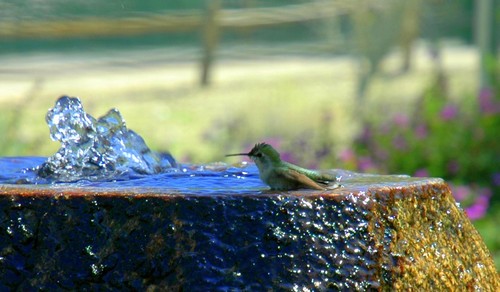
Getty Images
Hummingbirds have long been considered a symbol of joy and happiness and are said to bring good luck and positive energy to those who encounter them. So why not keep the good vibes going by creating a hummingbird hangout in your garden that can ensure these beautiful creatures return year after year?
“Adding a hummingbird-friendly spot in your garden, with a foundation of native plants, is an amazing way to support local wildlife and the broader natural environment,” says David Bryant, manager of campaigns and engagement at California Native Plant Society. “You’ll be rewarded with gorgeous floral displays, the beauty of these winged visitors, and a deeper sense of connection to the place you call home.”
Building a haven for hummingbirds is not as complicated as it sounds. By providing the basics like water, shelter, and colorful flowers, “you will be rewarded with the company of these wonderful wild birds,” says David Salman, chief horticulturist for High Country Gardens.
To begin, experts at Wilson Bros Gardens suggest creating a curved, narrow flower bed in an open area so that hummingbirds will have access to the flowering blooms from all sides. They also suggest planting your hummingbird garden near a deck, patio, or porch, or outside a window.
Here are a few other steps to take to bring the hummingbirds to you.
Pick a variety of plants and flowers
To help support the full life cycle of hummingbirds, experts recommend planting native flowering plants, vines, shrubs, and trees.
“Native plants like trumpet honeysuckle, bee balm, and hummingbird sage are just a few of the nectar-providing options that hummingbirds are attracted to,” says John Rowden, senior director for bird-friendly communities at the National Audubon Society.
Gardeners can use Audubon’s native plants database to find what plants are best for their local area.
“If you have space, it’s ideal to provide a variety of plants. Grouping similar plants together and choosing species with different blooming periods will help ensure that there is a steady supply of flowers and nectar,” says Rowden. “If done deliberately, you can support hummingbirds year-round—if you’re lucky enough to have them throughout the year.”
Katrina Godshalk for High Country Gardens says nectar-rich perennials are a good choice to plant in your hummingbird garden. She also endorses the practice of organic gardening methods, which can eliminate and restrict the use of chemical herbicides and pesticides.
Cultivate a natural ecosystem with insects
Hummers love sipping flower nectar, but did you know they eat insects, too?
An important part of an adult hummingbird’s diet is small spiders and insects, says Rowden, “and young hummingbirds still in the nest are almost exclusively fed on those protein-rich foods.”
To encourage spiders and insects in your hummingbird garden, Rowden says to make sure your yard has insect-pollinated flowers, hummingbird-pollinated plants, and native plants.
Provide a perch
Hummingbirds like their perches and spend up to 80% of the day sitting on one.
Salman says conifers, shade trees, and taller shrubs can create a sheltered perch “where the hummingbirds can rest, build nests, and safely survey their garden domain.”
“Leaving some sticks and small branches on bushes and trees will provide perches for hummingbirds,” says Rowden. He says it’s also important to place some in more sheltered spots hidden from the view of predators.
“Hummingbirds use bits of spider web, insect cocoons, and other lacy material to construct their nests,” says Bryant. “Be sure to leave some cobwebs in the nooks of tree branches and shrubs for hummingbirds to utilize.”
Gardeners can place bunches of dryer lint in the branches for nest-building.
Have plentiful water sources
Photo by Noelle Johnson Landscape Consulting
A water feature with a splashing fountain or dripper will also get the attention of hummingbirds.
“Hummingbirds like to bathe frequently—even in the pools of droplets that collect on leaves,” says Rowden. “Provide a constant source of water in your yard.”
Hummingbirds prefer water sources that drip or spray, Salman says—such as a fountain with multiple tiers that drip or a very low–volume mist nozzle attached to a branch or tree trunk. Make sure to put the mist nozzle or fountain in the open, “away from hiding spots where cats can hide and ambush the birds,” he says.
Consider feeder placement
Get ready to bird-watch once you hang a feeder! But remember, the location of the feeder is very important.
“Hummingbirds are territorial and will protect their nectar sources. Hang several feeders far enough apart that the hummingbirds cannot see one another; this will prevent one bird from dominating the rest,” says Rowden.
He also recommends hanging feeders in the shade to prevent the nectar from spoiling quickly. He notes that cleanliness is important with feeders, too.
“Be sure to change the nectar regularly, every few days,” says Rowden. “If it gets cloudy, it is spoiled.”
Clean feeders with a solution of one part white vinegar to four parts water about once a week, and rinse the feeder with warm water three times before refilling it.
The post How To Create a Hummingbird Hangout in Your Garden appeared first on Real Estate News & Insights | realtor.com®.

No comments:
Post a Comment